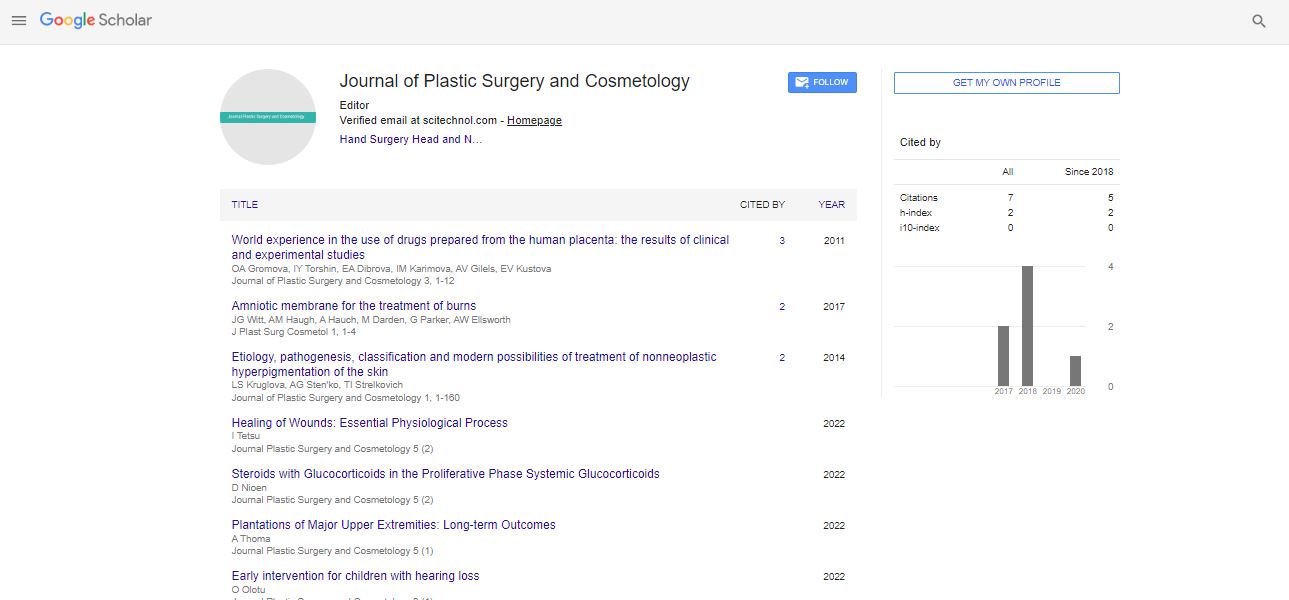Opinion Article, J Pls Sur Cos Vol: 12 Issue: 4
Precision and Perfection: Evolving Trends in Minimally Invasive Cosmetic Procedures
Tom Naciff*
1Department of Pharmacy, Liverpool John Moores University, Liverpool, UK
*Corresponding Author: Tom Naciff,
Department of Pharmacy, Liverpool John
Moores University, Liverpool, UK
E-mail: nacifftom6324@ljmusp.uk
Received date: 27 November, 2023, Manuscript No. JPSC-24-123940;
Editor assigned date: 29 November, 2023, Pre QC No. JPSC-24-123940 (PQ);
Reviewed date: 14 December, 2023, QC No. JPSC-24-123940;
Revised date: 21 December, 2023, Manuscript No. JPSC-24-123940 (R);
Published date: 28 December, 2023, DOI: 10.4172/JPSC.1000062
Citation: Naciff T (2023) Precision and Perfection: Evolving Trends in Minimally Invasive Cosmetic Procedures. J Pls Sur Cos 12:4.
Abstract
Description
In recent years, the field of cosmetic procedures has witnessed a paradigm shift towards minimally invasive techniques, revolutionizing the way individuals enhance their aesthetic appeal. These advancements not only offer reduced downtime and scarring but also provide patients with safer and more efficient alternatives to traditional surgical methods. This essay delves into the latest breakthroughs in minimally invasive cosmetic procedures, exploring their benefits, applications, and the transformative impact they have on the cosmetic industry.
The concept of minimally invasive procedures has evolved as a response to the growing demand for cosmetic enhancements with minimal disruption to daily life. Traditional surgical methods often involve lengthy recovery periods, significant scarring, and potential complications. Minimally invasive techniques aim to address these concerns by utilizing advanced technologies and innovative approaches. Laser technology has been a game-changer in the field of cosmetic procedures. Lasers offer precision and control, allowing practitioners to target specific areas with minimal damage to surrounding tissues. Laser treatments are widely used for hair removal, skin rejuvenation, and tattoo removal. The introduction of fractional laser technology has further enhanced the ability to address skin concerns with minimal downtime. The rise of injectables and dermal fillers has reshaped the landscape of cosmetic enhancements. Neurotoxins like Botox temporarily paralyze muscles, reducing the appearance of wrinkles and fine lines. Dermal fillers, on the other hand, provide volume and lift to areas affected by age-related volume loss. Continuous research in this field has led to the development of longer-lasting and more natural-looking products.
Thread lifts have gained popularity as a non-surgical facelift alternative. This technique involves the insertion of dissolvable threads under the skin, which lift and tighten sagging tissues. The threads stimulate collagen production, promoting a natural and longlasting rejuvenation. The latest advancements in thread lift technology focus on improving thread materials, reducing the risk of complications, and enhancing the precision of the procedure. Non Nonsurgical fat reduction techniques have emerged as effective alternatives to liposuction. Procedures such as cryolipolysis (CoolSculpting) and laser lipolysis target and eliminate stubborn fat deposits without the need for surgery. These methods have seen continuous refinement, with advancements in applicator design and technology resulting in more targeted and efficient fat reduction.
Energy-based devices, including radiofrequency and ultrasound, have revolutionized skin tightening procedures. These technologies stimulate collagen production, leading to tighter and more youthful skin. Continuous research has focused on optimizing energy delivery, ensuring safety, and expanding the applications of these devices to various body areas. One of the primary advantages of minimally invasive procedures is the significantly reduced downtime compared to traditional surgeries. Patients can often resume their daily activities shortly after undergoing these treatments, making them more accessible to individuals with busy lifestyles.
Minimally invasive techniques prioritize smaller incisions or no incisions at all, resulting in minimal scarring. This aspect is particularly appealing to individuals seeking cosmetic enhancements without the telltale signs of surgery. With advancements in technology and technique, minimally invasive procedures have become safer than ever. The risk of complications is lower, and the procedures are often performed on an outpatient basis, reducing the need for hospitalization.
Minimally invasive techniques have transformed facial rejuvenation procedures. From thread lifts to injectables, individuals can achieve a more youthful appearance without the need for extensive surgery. These techniques address concerns such as wrinkles, sagging skin, and volume loss. Non-surgical fat reduction and energy-based skin tightening have expanded the options for body contouring. Patients can now target specific areas for fat reduction and achieve a more sculpted physique without the downtime associated with traditional liposuction.
Advancements in minimally invasive hair restoration techniques have provided new hope for individuals experiencing hair loss. Procedures like Platelet-Rich Plasma (PRP) therapy and low-level laser therapy stimulate hair growth and improve hair density with minimal discomfort and downtime. As minimally invasive techniques continue to evolve, regulatory bodies must keep pace with the introduction of new technologies and procedures. Striking a balance between innovation and patient safety remains a key challenge in the cosmetic industry.
The successful implementation of minimally invasive procedures requires specialized training and skill. Practitioners must stay updated on the latest techniques and technologies to ensure optimal results and patient satisfaction. The future of minimally invasive cosmetic procedures holds exciting possibilities. Ongoing research and development are likely to bring forth new technologies, further refining existing techniques and expanding the range of applications. As the demand for cosmetic enhancements continues to rise, the emphasis on achieving natural-looking results with minimal intervention is expected to drive innovation in the field.
 Spanish
Spanish  Chinese
Chinese  Russian
Russian  German
German  French
French  Japanese
Japanese  Portuguese
Portuguese  Hindi
Hindi 